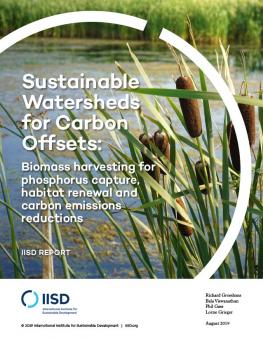
Sustainable Watersheds for Carbon Offsets: Biomass harvesting for phosphorus capture, habitat renewal and carbon emissions reductions
We have been exploring new and innovative practices to reduce flood impacts and nutrient loading, as well as to reduce carbon emissions, in the Lake Winnipeg watershed through better water retention management, and the harvest and use of sustainable wetland biomass.
-
IISD is proud to have pioneered the practice of harvesting cattails and other plants from water retention areas and drainage ditches to remove phosphorus from watersheds, improve wetland habitat, and produce an innovative and sustainable source of biomass for energy, compost and bioproducts.
-
Using this type of ‘unconventional’ waste biomass for energy or bioproducts has many added environmental benefits.
-
We can then apply those materials to the land to recycle nutrients (such as phosphorus and nitrogen) and to add organic material and carbon back to the soil—a key component of the circular economy.
Key Messages
- IISD is proud to have pioneered the practice of harvesting cattails and other plants from water retention areas and drainage ditches to remove phosphorus from watersheds, improve wetland habitat, and produce an innovative and sustainable source of biomass for energy, compost and bioproducts.
- Using this type of ‘unconventional’ waste biomass for energy or bioproducts has many added environmental benefits.
- We can then apply those materials to the land to recycle nutrients (such as phosphorus and nitrogen) and to add organic material and carbon back to the soil—a key component of the circular economy.
This review examines the benefits of applying biomass to land to improve soil health and examines current global carbon markets and initiatives since the Kyoto Protocol (1997) and the Paris Agreement (2015) to provide lessons from global carbon markets for Canada and Manitoba. We assess applicable carbon market verification methodologies to identify those that could be considered and modified for ongoing and future bioeconomy initiatives.
Here at IISD, we have pioneered innovative watershed management practices by harvesting cattails and other plants from marginal agricultural land, water retention sites and roadside drainage ditches to remove nutrients taken up by those plants. The abundant plant biomass can then be used for energy, bedding, compost and soil enhancement to generate carbon offsets from carbon dioxide displacement and sequestration.
This matters because the use of waste material is the foundation of the bioeconomy—where biological waste resources are converted into value-added products—and is at the core of the ‘circular economy,’ whereby resources are maintained in the economy for as long as possible to reduce waste.
Using ‘unconventional’ waste biomass also has other added benefits, which raises its environmental profile. Harvesting removes captured phosphorus before it gets into lakes, such as Lake Winnipeg, to be recovered and used as agricultural fertilizer. Removal of biomass also improves habitat health and biodiversity, improves flow to reduce flood impacts and helps control invasive species.
You might also be interested in
How can we improve on freshwater health and prevent plastic pollution?
INC-4 is the fourth meeting in a series of international negotiations that aims to develop a global treaty on plastic pollution, which can and should have big implications for freshwater quality both in Canada and beyond.
What Is the UAE Framework for Global Climate Resilience, and How Can Countries Move It Forward?
With the introduction of the new framework for the Global Goal on Adaptation (GGA), COP 28 marked a milestone for adaptation. We unpack key outputs and set out how countries can move forward by strengthening their national monitoring, evaluation, and learning (MEL) systems.
India's stance at WTO balances fisheries subsidies for artisanal fishers and sectoral growth
India is likely to advocate for securing the interests of its artisanal fishers while facilitating the growth of the fishing sector at the World Trade Organisation's 13th Ministerial Conference (MC13) in Abu Dhabi later this month. At the MC13, scheduled from February 26 to February 29, world leaders will negotiate on regulating fisheries subsidies that contribute to excessive fishing effort and capacity.
National State of the Environment Report: Uzbekistan
The National State of the Environment Report (NSoER) is a comprehensive document that provides a snapshot of current environmental trends in Uzbekistan's socio-economic development for citizens, experts, and policy-makers in the country of Uzbekistan.